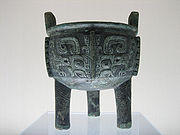
Ding (vessel)
Encyclopedia

China
Chinese civilization may refer to:* China for more general discussion of the country.* Chinese culture* Greater China, the transnational community of ethnic Chinese.* History of China* Sinosphere, the area historically affected by Chinese culture...
cauldron
Cauldron
A cauldron or caldron is a large metal pot for cooking and/or boiling over an open fire, with a large mouth and frequently with an arc-shaped hanger.- Etymology :...
with legs, a lid and two handles opposite each other. They were made in two shapes with round vessels having three legs and rectangular ones four.
Dings were originally made of ceramic
Ceramic
A ceramic is an inorganic, nonmetallic solid prepared by the action of heat and subsequent cooling. Ceramic materials may have a crystalline or partly crystalline structure, or may be amorphous...
materials then later, at the time of the Shang Dynasty
Shang Dynasty
The Shang Dynasty or Yin Dynasty was, according to traditional sources, the second Chinese dynasty, after the Xia. They ruled in the northeastern regions of the area known as "China proper" in the Yellow River valley...
(1600-1046 BCE), cast in bronze
Bronze
Bronze is a metal alloy consisting primarily of copper, usually with tin as the main additive. It is hard and brittle, and it was particularly significant in antiquity, so much so that the Bronze Age was named after the metal...
. This is the period to which the oldest examples of dings date back. Inscriptions found on dings and zhongs are used to study bronzeware script
Bronzeware script
Chinese Bronze inscriptions are writing in a variety of Chinese scripts on Chinese bronze artifacts such as zhōng bells and dǐng tripodal cauldrons from the Shāng dynasty to the Zhōu dynasty and even later...
. They were used for cooking, storage and the preparation of ritual offerings to ancestors.
In Chinese history and culture, possession of one or more ancient dings is often associated with power and dominion over the land. Therefore, the ding is often used as an implicit symbolism for power. The term "inquiring of the ding" is often used interchangeably with the quest for power.
Perhaps the most famous ancient dings were the Nine Tripod Cauldrons
Nine Tripod Cauldrons
According to legend the Nine Tripod Cauldrons were created following the foundation of the Xia Dynasty by Yu the Great, using tribute metal presented by the governors of the Nine Provinces of ancient China....
. This set of bronze vessels is said to have been cast by King Yu
Yu the Great
Yu the Great , was a legendary ruler of Ancient China famed for his introduction of flood control, inaugurating dynastic rule in China by founding the Xia Dynasty, and for his upright moral character....
of the Xia Dynasty
Xia Dynasty
The Xia Dynasty is the first dynasty in China to be described in ancient historical chronicles such as Bamboo Annals, Classic of History and Records of the Grand Historian. The Xia Dynasty was established by the legendary Yu the Great after Shun, the last of the Five Emperors gave his throne to him...
when he divided his territory into the Jiuzhou or Nine Provinces. Later on, possession of all nine was considered a sign of rightful authority over all
All under heaven
Tianxia is a phrase in the Chinese language and an ancient Chinese cultural concept that denoted either the entire geographical world or the metaphysical realm of mortals, and later became associated with political sovereignty.In ancient China, tianxia denoted the lands, space, and area divinely...
. The whereabouts of the nine ding are presently unknown, but are said to have been lost during the imperial
Early Imperial China
Early Imperial China begins in the Iron Age with the unification of China by the Qin dynasty in 221 BC. It ended five centuries of feudal warfare, similar to that of Western Europe, that plagued the Eastern Zhou dynasty. The short-lived Qin introduced centralized government under the absolute...
Qin Dynasty
Qin Dynasty
The Qin Dynasty was the first imperial dynasty of China, lasting from 221 to 207 BC. The Qin state derived its name from its heartland of Qin, in modern-day Shaanxi. The strength of the Qin state was greatly increased by the legalist reforms of Shang Yang in the 4th century BC, during the Warring...
(221-206 BCE), after having been passed among various royal dynasties and feudal states.
The architecture of the Shanghai Museum
Shanghai Museum
The Shanghai Museum is a museum of ancient Chinese art, situated on the People's Square in the Huangpu District of Shanghai, People's Republic of China.-History:...
is intended to resemble a bronze ding.
External links
- "Part Two: Bronze Age China: More about Bronze Vessels", National Gallery of ArtNational Gallery of ArtThe National Gallery of Art and its Sculpture Garden is a national art museum, located on the National Mall between 3rd and 9th Streets at Constitution Avenue NW, in Washington, DC...
, Washington, D.C. - Picture of a ding - The Epoch TimesThe Epoch TimesThe Epoch Times is a multi-language, international media organisation. As a newspaper, the Times has been publishing in Chinese since May 2000. It was founded in 1999 by supporters of the Falun Gong spiritual discipline....
newspaper website (text in Chinese) - Da Ke Ding, in Shanghai Museum
- Ding (ritual vessels) in Art & Architecture Thesaurus (Taiwan)

